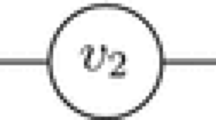Abstract
We discuss the limit distribution of open quantum walks on the periodic graphs, particularly on the cycles. We show that under certain hypothesis, we can benefit from the theory of the classical Markov chains. Thereby we can show that under certain condition the stationary distribution is unique. For certain models, we show directly the stationary distribution. We also notice that the open quantum walks cannot be always modeled as classical Markov chains by showing that it can break some classical probability rule. By providing with some examples, we show that there can be multiple stationary states for the open quantum walks on the cycles.

Similar content being viewed by others
Explore related subjects
Discover the latest articles, news and stories from top researchers in related subjects.References
Attal, S., Guillotin-Plantard, N., Sabot, C.: Central limit theorems for open quantum random walks and quantum measurement records. Ann. Henri Poincaré 16(1), 15–43 (2015)
Attal, S., Petruccione, F., Sabot, C., Sinayskiy, I.: Open quantum random walks. J. Stat. Phys. 147, 832–852 (2012)
Attal, S., Petruccione, F., Sinayskiy, I.: Open quantum walks on graphs. Phys. Lett. A 376(18), 1545–1548 (2012)
Carbone, R., Pautrat, Y.: Open quantum random walks: reducibility, period, ergodic properties. Ann. Henri Poincaré 17, 99–135 (2016)
Dhahri, A., Mukhamedov, F.: Open quantum random walks, quantum Markov chains and recurrence. Rev. Math. Phys. 31(7), 1950020 (2019)
Fàbrega, J.: Random walks on graphs, Lecture Note (2011)
Grimmett, G.R., Stirzaker, D.R.: Probability and Random Processes, 3rd edn. Oxford University Press, Oxford, New York (2001)
Ko, C.K., Konno, N., Segawa, E., Yoo, H.J.: Central limit theorems for open quantum random walks on the crystal lattices. J. Stat. Phys. 176, 710–735 (2019)
Ko, C.K., Yoo, H.J.: Entropy production of quantum Markov semigroup associated with open quantum walks on the periodic graphs. Quantum Inf. Process. 22, 81 (2023)
Konno, N., Yoo, H.J.: Limit theorems for open quantum random walks. J. Stat. Phys. 150(2), 299–319 (2013)
Kümmerer, B., Maassen, H.: An ergodic theorem for quantum counting processes. J. Phys. A Math. Gen. 36, 2155–2161 (2003)
Kümmerer, B., Maassen, H.: A pathwise ergodic theorem for quantum trajectories. J. Phys. A Math. Gen. 37, 11889–11896 (2004)
Lardizabal, C.F.: Open quantum random walks and the mean hitting time formula. Quantum Inf. Comput. 17(1/2), 79–105 (2017)
Lardizabal, C.F., Souza, R.R.: Open quantum random walks: ergodicity, hitting times, gambler’s ruin and potential theory. J. Stat. Phys. 164(5), 1122–1156 (2016)
Lindblad, G.: On the generators of quantum dynamical semigroups. Commun. Math. Phys. 48, 119–130 (1976)
Lovász, L.: Random walks on graphs: a survey. Bolyai Society Mathematical Studies, vol. 2. Keszthely (1993)
Umanita, V.: Classification and decomposition of quantum Markov semigroups. Thesis, Politecnico di Milano (2005)
Acknowledgements
We are grateful to anonymous referees for their valuable comments, which greatly improved the paper. We thank Mrs. Yoo Jin Cha for drawing the figures. The work of H. J. Yoo was supported by the National Research Foundation of Korea (NRF) Grant funded by the Korean government (MSIT) (No. 2020R1F1A101075).
Author information
Authors and Affiliations
Contributions
C.K.K and H.J.Y wrote the main manuscript and all authors reviewd the manuscript.
Corresponding author
Ethics declarations
Competing interests
The authors declare no competing interests.
Additional information
Publisher's Note
Springer Nature remains neutral with regard to jurisdictional claims in published maps and institutional affiliations.
Appendix: Generating matrices under Hypothesis (H)
Appendix: Generating matrices under Hypothesis (H)
In this appendix, we give the explicit expression of the rank 1 matrices \(B^*P_iB\) and \(C^*P_iC\) for \(i=1,2\) under the Hypothesis (H).
Let us denote the unitary matrices \(U_B\) and \(U_C\) appeared in the singular value decomposition of B and C in (3.5) by
Lemma A.1
Let B and C have the singular value decomposition as in (3.5) and satisfy the hypothesis (H). Then the rank 1 operators \(B^*P_iB\) and \(C^*P_iC\), \(i=1,2\), have the following forms:
(i) Case 1: \(0<\lambda <1\), \(0<\mu < 1\).
and similarly,
(ii) Case 2: \(0<\lambda <1\), \(\mu =0\).
(iii) Case 3: \(0<\lambda <1\), \(\mu =1\).
(iv) Case 4: \(\lambda =0\), \(0<\mu <1\).
(v) Case 5: \(\lambda =1\), \(0<\mu <1\).
(vi) Case 6: \(\lambda =0\), \(\mu =1\).
(vii) Case 7: \(\lambda =1\), \(\mu =0\).
(viii) Case 8: \(\lambda =0\), \(\mu =0\) or \(\lambda =1\), \(\mu =1\).
These cases result in \(B=0\) or \(C=0\), respectively, and are out of consideration in the model.
Proof
The proof follows easily by using the Hypothesis (H) and the fact that the operators \(B^*P_iB\) and \(C^*P_iC\) are of rank 1. \(\square \)
Rights and permissions
Springer Nature or its licensor (e.g. a society or other partner) holds exclusive rights to this article under a publishing agreement with the author(s) or other rightsholder(s); author self-archiving of the accepted manuscript version of this article is solely governed by the terms of such publishing agreement and applicable law.
About this article
Cite this article
Ko, C.K., Yoo, H.J. Ergodicity and limit distribution of open quantum walks on the periodic graphs. Quantum Inf Process 23, 159 (2024). https://doi.org/10.1007/s11128-024-04367-0
Received:
Accepted:
Published:
DOI: https://doi.org/10.1007/s11128-024-04367-0



